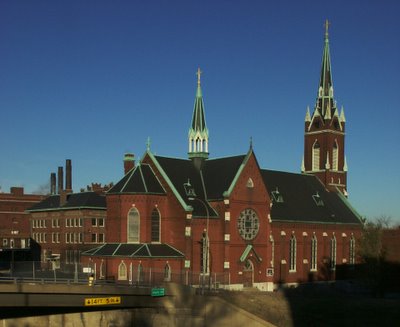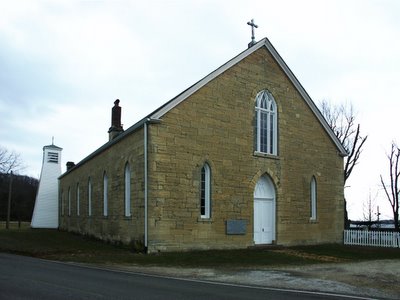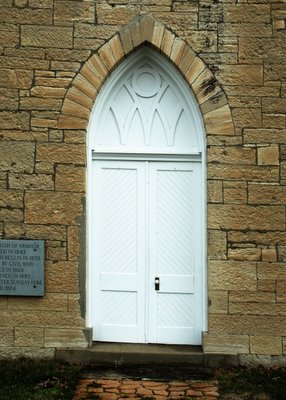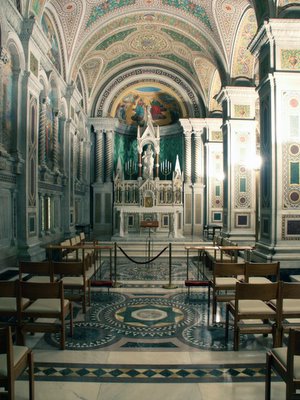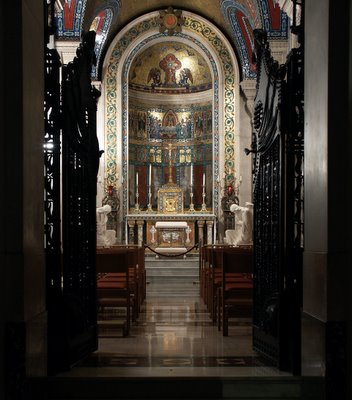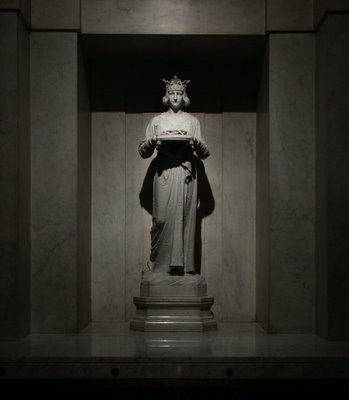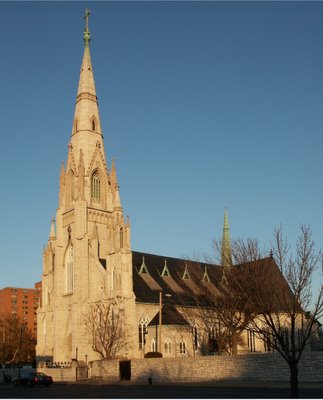I just finished reading
Why Men Don't Listen and Women Can't Read Maps, by Barbara and Allan Pease, published in 2001. The title gives a good overview of roughly the first half of the contents. This book is a quick read, informative, and is entertaining, but it is also rather explicit in places, and it contains an
apologia for homosexuality.
The book describes and explains several key differences between the sexes, as its title suggests. It is completely secular, and is based on evolutionary biology, medical studies, and surveys. The authors claim to be politically incorrect in their analysis, and that is a refreshing diversion from the Marxist-inspired political oppression of Feminism.
The main point of the book is that men and women think and act differently—as a biological fact, not caused by social conditioning—and takes the true philosophical stance that differences in kind are
not differences in value. Both chauvinists and feminists make the same mistake, that to be different in kind
is to be different in value: because of this, feminists think that there is no difference between men and women, while chauvinists think that one sex is superior to the other even though they are not comparing the same attributes.
The equal ontological value of all persons is very Catholic, with roots going back to ancient Israel, and it is such an important concept and matter of faith because we can demonstrate that it is true
. Stray from orthodoxy and you get slavery, chauvinism, feminism, and genocide.I found the first part of the book more enjoyable, since it is anecdotal, humorous, and sometimes painfully familiar. For example:
- Women tend to be able to do many things at one time, and can carry on multiple conversations at one time, while overhearing other conversations. Men tend to talk in turn, using fewer words and a much more concrete vocabulary.
- Men usually cannot both listen to conversation and to either read, work or watch television. A man engrossed in his work or reading is nearly psychologically deaf.
- Women use words in a fluid fashion: 'yes', 'no', 'always', and 'never' do not have definite, absolute meanings.
- A woman's hearing is tuned to the shrill cry of a baby; a man's hearing is tuned to distant sounds of motion. Both will instantly wake up from sleep if their particular kind of sound is present, and will usually sleep though the other.
- Men tend to be able to imagine things in three dimensions, and is able to mentally rotate both two and three-dimensional models. Women usually can't imagine in three dimensions, and find it difficult to even rotate a mental image in two dimensions.
- Men tend to be able to use maps for navigation, are able to discern North without a compass or celestial clues, and can recall large amounts of spatial information. With a good map, a man can usually find his way just knowing the starting and ending point. Women tend to be frustrated by maps, and tend to turn them in the direction that they are going. Women tend to need many landmark descriptions and left-right directions for navigation; men more often can use distance and compass directions.
- Women have a broader field of view, and can observe activity without turning the head or moving the eyes. Men's eye focus is typically much narrower, requiring head-turning and staring for observation.
- Men excel at activities that require analysis of motion, velocity, and position. Women have a terrible time parallel parking.
- Men typically can't lie to a woman, since she can pick up on subconscious nonverbal clues.
- Women, upon entering a crowded room, size up the people and their relationships. Men tend to mentally map out the room, seek entry and exit points, food locations, and analyze the state of repair of the building structure.
- Women usually excel at jobs requiring close human relationships and multitasking. Men usually excel at jobs that require numerical, spatial and motion ability.
- Men naturally form themselves into hierarchies, choosing the best as their leaders, and making decisions by debate. Women form small collaborative groups, where aggressiveness is frowned upon.
- Men overwhelmingly identify themselves with their work. Women overwhelmingly identify themselves with their relationships.
- Women show and use facial expressions far more than men do. Men tend to avoid the use of facial expression.
- Men tend to need a lot of silence for thinking, planning, and relaxation. Women use silence as a sign of rejection.
- Women need to talk out problems, and will be restless and "mind-racing" if unable to hold a conversation. Men tend to be able to compartmentalize thoughts silently
- Men under stress talk less. Women under stress talk more.
- Men tend to be able to utilize statistics, numerical measures, and charts.
- Women tend to be able to distinguish more colors and odors.
- Women tend to be far more sensitive to touch than men.
- Women tend to better nurses, primary school teachers, interpreters, manual detail workers, and secretaries. Men tend to be better ball players, engineers, scientists, tradesmen, architects, and accountants. In school systems where an equal sex ratio between teachers is enforced, women dominate conversational language courses, and men dominate the sciences.
Since this is a modern book, the authors take great pains to provide scientific evidence for these conclusions, although some of them are "duh" moments, kind of like a scientific study that determines conclusively that fish, generally, live in water, although it is not certain whether it is due to genetic, environmental, or social conditioning. Scientists are known for often lacking common sense.
These sex differences are shown to be generally due to differences in brain structure. Men have specialized portions of the brain for navigation, aiming, catching, estimating velocities, and generating three-dimensional mental maps. Women have specialized centers for speech and hearing. When a person lacks these centers of specialization, more thought is required, and they tend to be either incapable or very slow at doing these tasks.
The authors state that hormone exposure during early pregnancy causes this brain specialization, and since this process is somewhat separate from primary sexual development, variations in these hormones is what causes an inclination to homosexuality. These variations during pregnancy are typically due to excessive stress in the mother, although some common drugs prescribed in the 1950s and 1960s had a great affect. The authors completely discount social factors after birth.
The book is full of practical advice to avoid conflict between the sexes.
- For men: talk more, actively listen more, be generally nice and gentle to women.
- For women: talk less, express requests in a concrete and direct manner, give a man plenty of time alone.
Generally, the authors suggest that we need to accept human nature and not try to force-fit people into roles for which they are ill-suited. This is a step towards right reason. Virtues, after all, have an objective component, but are also affected by each individual's circumstances, nature, and state of mind.
The last part of the book talks about sex and relationships. It sees monogamy as being basically the desire of women and is for the good of society. It rejects the feminists' masculine sexuality as being against the nature of most women. That is obvious for me...as a ten year old kid I saw that the feminists of that era were not like other women, and were changing society for their own selfish desires and not for the good of the majority of women.
Catholicism has a rational view of morality that is based in human nature, and it rejects modern theories like utilitarianism and feminism that denies this nature. Traditional Catholicism has long had specific roles for men and women that used their separate abilities in a wise and natural manner. Much nonsense of the past several decades is due to a thoughtless egalitarianism that says that men and women are the same in both kind and value.
Men are hierarchical in their social structure, granting leadership to the strong and just. God, however, is the strongest and the most just: he can and does lay waste to nations and grants plenty or allows famine to rule the land; men can recognize this, and therefore can naturally organize themselves into a hierarchy with God at the top. That the priesthood and ecclesial structure is hierarchical is quite natural to men. But men can willfully obey his superior only as long as the superior is just and orthodox; having a heretic as a leader is distressing to men. Men who are drawn to the current heresy in the Church seem to be feminine thinkers, who don't respect authority, and who work through personal relationships instead of the chain of command. A masculine religion that completely excluded women would lack the social aspects of caring for the sick and poor and teaching the very young, and would tend to be violently expansionist.
Women are more collaborative, seeing each other as friends and expecting equal treatment. Women in the Church excel in upholding the Communion of Saints and popular devotion. It is the women who raise the next generation of Catholics, women who form prayer groups, and women who rule the parish hall. Historically, women made up the vast majority of Religious, and did the bulk of the social aspects of the Church. Women tend to have great devotions to the Saints, who are
just like us, and are our
friends. Feminine-only religion has its problems. Seeing God—the Creator of the Heavens and the Earth—as just a good friend can lead to tremendous disappointment when things go badly. Anglican Priestesses are notorious for having heretical New Age views, as do many 'masculinized' female religious orders in the Catholic Church. I've noticed that women who attempt to do what most men do naturally often end up being perverse imitations of the worst sort of men. Also, women can end up spending much money on superstition: occultists prey almost entirely on women, for women like the intuitive aspect of things like fortune telling. Modern 'spiritual' foods and cosmetics that promise "salvation through consumption" can be very expensive: "Whole Foods" supermarkets has the disparaging nickname "Whole Paycheck". For this reason, the spiritual goods of the Church are always and everywhere free of charge, by Canon Law; we had the Reformation when this was ignored.
Women have been key to upholding the Church under extreme persecution. It was women and just one boy who were with Christ when he was on the Cross, while the men ran and hid. In the days of the Soviet Union, mainly women would attend Divine Liturgy, even when being spied on by the State, and up to 80% of all children were baptised, thanks to the women who defied the authorities.
Societies where women do the architecture are societies that live in huts made of sticks covered with mud; women just want or have to do too much else than spend much time constructing a house. Societies where men do the architecture have complex, large, beautiful, and durable buildings. The hierarchical organization of men leads to specialized trades that are expert in certain fields, and when these groups organize themselves under a leader with clear direction, great buildings can be made. Feminized architecture emphasizes passing trends, is built cheaply, and tends to be horizontal. Modern churches, which have a congregational feel, allow the parishoners to see
each other, while masuline church architecture is vertical, with the order of worship towards the altar. Also, masculine architecture is far more three-dimensional, while feminine architecture has a simpler two-dimensional structural aspect. Modern architecture often is an inversion of the natural male/female exterior/interior emphasis, with simplistic, cheap structures and cold, brutal interiors, instead of the natural complex and durable exteriors, and warm, loving, and comfortable interiors.
The institution of marriage, as seen by the authors of the book, is primarily based on the desire of women and is for the good of society. Catholic Natural Law sees this in a somewhat similar fashion, and holds marriage in the highest esteem. This is a Sacrament that is overwhelmingly dominated by women, and in Catholic theology, is performed by the couple themselves and merely witnessed by a Priest or Deacon. The evidence shows that the weakening of the institution of marriage that started in the Reformation has been more directly harmful to women and children than to men, and attempted solutions to these problems has led to a vast reorganization of society and an expensive government.
The authors of this book emphasize that men need to romance women for long-term happiness, and that couples who marry or move in together while still in an initial infatuation may be headed for trouble. The authors say that this stage lasts for about three to six months. Catholic custom, law, and moral theology demands extended courtships, a minimum of six months, and prohibits "shotgun weddings" and "marriages of convenience". Not surprisingly, by following the rules, marriage will take place only after the infatuation stage is over. Also, the art of romance is greatest in Catholic countries: men must put a great effort into wooing a woman long enough to marry her; this is most true if sexual activity is delayed until after the wedding. Formerly Catholic countries like France have recently changed to an American-style infatuation-based, romance-free dating life, which usually does not lead to marriage, but just a long series of broken relationships that end when infatuation is over.


